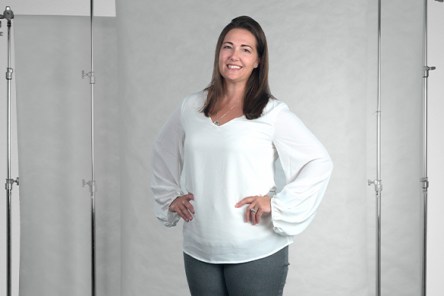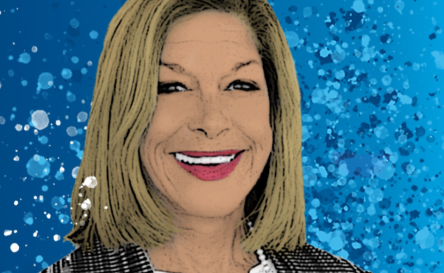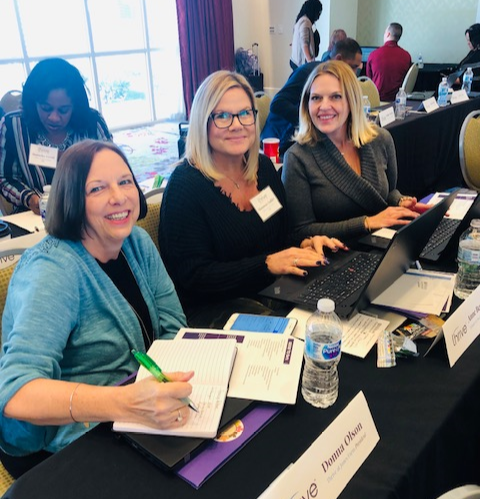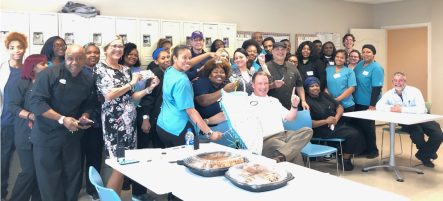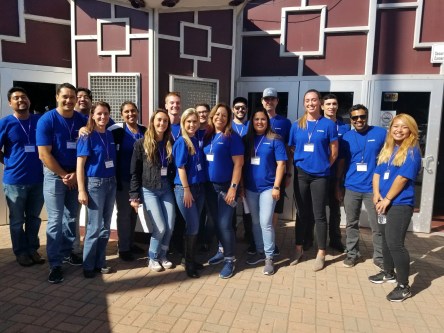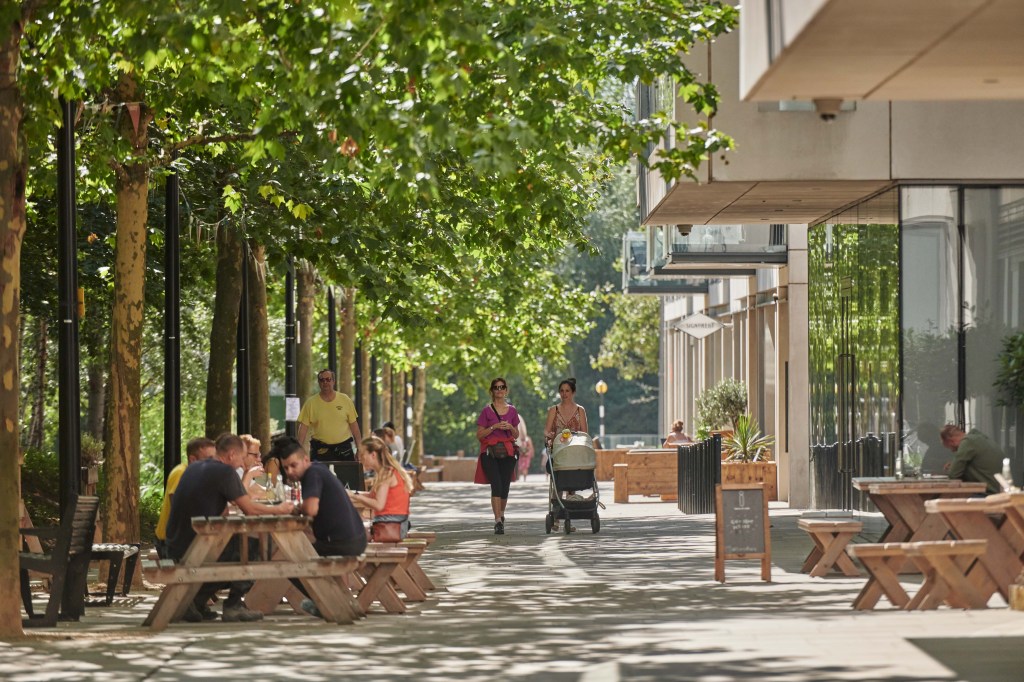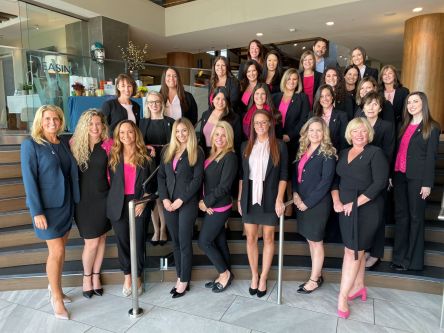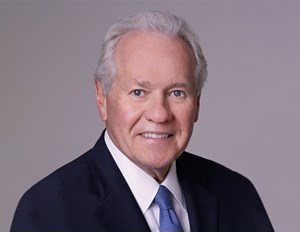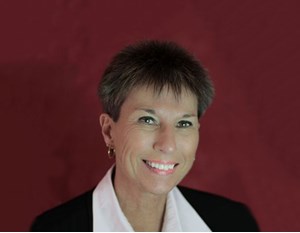How do you efficiently run an affordable assisted living community? We spoke with Nicole Graham to get the answers. Nicole is a licensed administrator for Nevada HAND, the largest nonprofit for affordable housing in the state. They’ve helped thousands find a place to call home – including older adults. Nevada HAND owns and operates two affordable assisted living communities in Las Vegas under the Silver Sky brand. Nicole’s in charge of their location at Deer Springs. Nicole revealed how they grow their community, connect with family members and provide the best possible care for residents through the Yardi Senior Living Suite. We’ve transcribed a few highlights from the interview here, but be sure to catch the video below too. Q: What Yardi products have been most transformative for you and why? We have definitely enjoyed Yardi EHR and Senior CRM. On the marketing side, it’s about knowing where our prospects are coming from and if we want to go back to that market area. But then once they are a prospect in the lead database, it goes all the way through the workflow on to the care side with EHR. Just being able to visually see that whole process has been really great. Q: How does your team maximize lead conversion with Senior CRM? Because you’re able to see the reports and analytics in Senior CRM, we know how long each lead takes and why they might not have moved in. We understand where we are at with that prospect. Are they in rehab? Are they still at home making the decision? Are they over resource because of our affordability and our income limits? Or are they waiting on other resources because they need to make the rent limit? So knowing those lead conversion...
Advocating Accounting...
Spotlight on property professions
In honor of National Apartment Careers Month, we shine a spotlight on professions within the multifamily housing industry. Accountants embrace a multifaceted career that stays relevant even when the winds of change blow their hardest. Their versatile skills sets prove useful in various arenas of the field, offering the professionals options for growth and new challenges. Across the board, accountants enjoy the dynamic atmosphere of the housing industry. It’s not a matter of sitting at a desk for hours, pushing paper and crunching numbers on the same tasks day after day. Tiffany Godley, Senior Accountant at Avison Young, values the flexibility offered by the field because it allows her to remain passionate about her job and interested in her continued growth. “It’s not monotonous by any means. There are new challenges every day; the market is changing every day. Real estate offers so many different avenues to take: apartments, retail, hotels, commercial properties, building–once you’re in, you’ve got so much flexibility. It’s actually hard to get bored.” That flexibility comes in the form of vertical and latitudinal job tracks. Real estate firms open a world of career options for accountants. Sandy Roberts, Controller at Thomson Companies, discovered that her degree and experience qualified her to wear many hats within the company. “[A controller’s] responsibilities can vary, from financials from the beginning to the end of projects, as well as human resources, payroll and beyond. Accountants are under a large umbrella with lots of potential.” Such endless possibilities make accountants an invaluable part of the housing industry. “Accountants become the go-to person that’s always in demand,” she says. Such demand has not seemed to dwindle in face of increasingly sophisticated software. Rather, advances in technology have enabled accountants to perform their jobs more efficiently without...
Staff Appreciation
Ideas for Feb. 15
Do you have members on your team that go above and beyond the call of duty? Or maybe you want to reassure your staff that their opportunities are just that—opportunities! There are several reasons for employee appreciation efforts. But unless you can offer family vacations and luxury cars for everyone, you may struggle with affordable ways to convey that you care. Show your team some Valentine’s Day love with these creative and inexpensive staff appreciation ideas. First Things First—Thank Them Have you actually said, “Great work” or” Thank you”? If not, start there. The phrases are so simple but when they’re sincere, they’re effective and motivating. While exploring the other ideas on this list, be sure to include a verbal and/or written word of thanks to make the maximum impact. Affordable Group Outings Organize a free, outdoor activity for your staff. Consider a group hike, walk, frisbee golf, or team sport at a local park. Such activities encourage team members to get active (ahem, lower health care costs) while building camaraderie. Team Yoga Corporate yoga classes are another great way to unwind. Yoga can teach employees healthy ways to destress, control their emotional responses, boost energy, and improve sleep. The possible benefits are truly endless! Host a visiting teacher at your office to include as many employees as possible at a reasonable rate. You can also request a private class for your group at a local studio. Many studios will provide mats and affordable pricing for private groups. To accommodate the most students, consider a basic hatha or restorative yoga practices. Community Activities Many neighborhoods host inexpensive activities that can serve as a fun outing for your team–and you don’t have to organize the events! Outdoor movies, concerts, festivals, and food fairs are easy...
Making History
Dominium + Affordable Housing
Dorothy Day Place, owned and operated by Catholic Charities of St. Paul and Minneapolis, has made history. With 370 permanent supportive homes and 356 emergency and medical respite beds, it’s one of the largest affordable housing projects in the state. The project is also the largest public-private partnership involving housing in Minnesota history. Dorothy Day Place was made possible in part by a philanthropic collaboration between Catholic Charities and Yardi client, Dominium. New Phase, New Chapter in History Dorothy Day Place wasn’t planned as a record-breaking collaboration. With the first phase complete, Catholic Charities turned its attention to phase two in 2017. Leadership recognized that the ambitious second phase would benefit from the insight and expertise of an experienced developer. Catholic Charities contacted Dominium, one of the country’s largest affordable housing developers and a fellow Minnesota-based organization. The response of Paul Sween, managing partner of Dominium, took Catholic Charities by surprise. Sween offered to develop the second phase of Dorothy Day Place free of charge. Perhaps to Sween’s surprise, the initial request came from the bank. “We instinctively said ‘yes’ to helping with the project when our partner U.S. Bank asked us to do so simply because we knew how important it was to them,” Sween explained in an interview with Housing Finance. “We know the great work of Catholic Charities and how critical the transformation of the property would be to their mission.” Dorothy Day Place broadens the scope of Dominium’s work. Historically, the firm develops and manages affordable housing for people who earn at or below 60 percent of the area median income. The Dorothy Day Place project serves residents with incomes below 30 percent of the area median income. Jeff Huggett, vice president and project partner at Dominium explains, “Every unit...
Become a Yardi Ambassador
New program for clients
If you are a Yardi client with an affinity for the technology that has helped better your business, the new Yardi Client Ambassador Program might be a perfect fit for you. This special opportunity for engaged clients is a great opportunity to share feedback, engage on social media, speak with other clients about your tech experience and much more. It’s easy to participate and requires only the level of engagement that works for you. The Yardi Ambassador Program is a direct-to-client engagement program that identifies and engages some of our most enthusiastic, passionate, experienced and strategic clients. These clients reflect Yardi’s markets, products, services and priorities and help contribute to our reference program, marketing content creation, and speakers for Yardi’s regional and corporate events. Sean Geraghty, manager of the program, explained how it works: “The new Ambassador program evolves how Yardi plans to work with some of our most passionate and enthusiastic clients. By formalizing our customer marketing process, we are making it easier than ever to allow Yardi’s clients to interact with us on social media, participate in the creation of marketing content, and share their leadership and knowledge by speaking at our many events,” said Geraghty. In other words, we know clients love to hear about other clients’ experiences using Yardi products, and this program will help facilitate that. “We are also making it easier for us to express our gratitude and thanks to our customers by providing fun rewards and incentives to those clients who participate,” Geraghty concluded. “We want to dialogue with you. Building on our Yardi history of client relationship prioritization, we hope the Ambassador Program will lead to strong relationships and conversations in the months and years to come.” Highlights of the program for clients include: Any customer can participate, regardless of company size or length of contract. Limited engagement includes simply liking social media channels or completing a software review. More involved engagement includes marketing interviews and sharing your success with Yardi products. If you are interested in speaking at Yardi events as a client panelist, this is your chance! Select your level of involvement on our easy online signup form. Does this sound like a good fit for you? Learn more and sign up here....
Changes in the Clouds
CIO + CFO Role Shifts
Cloud services have changed the roles of executives. CIOs implement fewer on-premises applications. Their technical infrastructure needs have evolved within the Internet of Things. CFOs now mold their capital expenditures pitches to address operations. In the center of those changes floats the cloud, and with it, the continually evolving roles of executives. The Balance Sheet caught up with Shawn Cardner, executive VP, multifamily operations and IT, Grubb Properties, to discuss the evolution on leadership. “The real estate industry, which arguably was slower to adopt technology, now can’t escape its influence,” explains Cardner. “Almost all multi-family marketing is digital, and big data now plays a role in many firms’ daily decision-making and long-term asset strategies. Firms that wish to remain competitive must integrate the CIO role into their overarching business strategy in order to reduce costs and increase revenue.” Benefits of the cloud for CIOs and CFOs The cloud offers several benefits for CIOs and CFOs, specifically. Scalable Solutions Through the cloud, CIOs can capitalize on features and services for small and medium-sized companies that were previously available to large companies. “Being able to play in the same sandbox as the largest of our peers allows us to be competitive in spaces where we might not otherwise be able,” says Cardner. Faster Implementations Finance teams are not dependent upon IT for support. As a result, implementations are rolled out with less friction during office hours and more work can be accomplished, faster. Specialized Software Support When using Yardi Cloud Services and Yardi Voyager to manage the general ledger, for example, the IT team does not invest resources in maintaining the accounting software. Updates and security are managed off-site by Yardi. Finance owns the application but supports the business processes in a more specialized manner. Cardner adds, “It’s worth noting that different challenges exist. There are fewer technical skills required of my team with a full-service solution like Yardi. There are, however, more nuanced soft skills and relationship skills required of us, which are sometimes difficult to find within technology circles.” Shorter Queues for IT With Cloud-based applications, there is less demand for IT to manage hardware or software. This often results in lower on-premises infrastructure costs. CFOs and their departments experience improved time to value, greater autonomy, and maintain ownership of software without being hampered by implementation or management during office hours. CIOs and their teams reduce hardware and software support, may decrease total cost of ownership, and can focus on specialized tasks. Addressing the risks Conversations about the cloud inevitably include risk management, security, and compliance. CIOs, CFOs, and COOs must collaborate proactively mitigate risks. “There is a tendency to recoil from the cloud when news of breaches occurs because of the bad press and notoriety. I’m reminded, however, of an IT saying, ‘The cloud is just someone else’s computer.’ An open port on a firewall turns an entire network into an unwanted cloud service, so diligence and thoroughness are necessary, regardless,” explains Cardner. He continues, “Modern security technology is quite robust, whether on-premise or in the cloud. The weak link of security in today’s age is people. Malware, ransomware, phishing and much of all data theft and loss are a result of improper employee conduct or inadequate employee training. When vetting a new cloud provider, that’s where my focus lies.” The future of leadership The value of infrastructure continues to be an integral part of CIO responsibilities. Even with available outsourced and cloud-based solutions, CIO’s still need to consider infrastructure and its strategy fundamental to the job. Yet now more than ever before, CIOs are becoming strategists. The emphasis shifts to discerning which services an organization needs to thrive rather than focusing on infrastructure. “Traditionally, CIO’s were strictly service providers and, in many organizations, didn’t sit at the table where strategy decisions were made. However, the proliferation of digital technology across and within organizations now mandates a level...
Senior Living Leaders...
Get the Changemakers Ebook
New regulations. Rising acuity. Huge demographic shifts. There’s no doubt that senior living as an industry is changing. And it’s changing faster than many providers are ready for. But there are a few who are facing these challenges head on, ready to adapt with novel practices and new technologies. Earlier this year, Senior Housing News spoke with nine such leaders in senior living as part of a series they call the Changemakers, sponsored by Yardi. They published the interviews individually over the past few months (and we chronicled a few here on The Balance Sheet), but they’ve now compiled the highlights – along with the leaders’ accomplishments, tips and insights – in a complete ebook for your reading pleasure. Download the ebook to learn how these senior living innovators are pushing the industry forward. There’s a wealth of experience and learnings shared throughout the pages, so you don’t want to miss it. Not convinced? Here are a few great excerpts: “[Our] program has been studied by Vanderbilt University. What we’ve learned is that, one, residents who experience mild cognitive impairment can thrive within assisted living, and also that it’s possible, as I said, to change the trajectory of the disease process. That’s a mind-bending accomplishment, particularly for a disease process that still has no medicinal cure.” – Patricia Will, Co-Founder & CEO of Belmont Village Senior Living “We have people who have lived long lives, who have gained life experience and, hopefully, some wisdom. Now, there’s that opportunity not just to sit on the front porch in a rocking chair, but to become engaged with the world around you and to share that wisdom, to share that life experience out into the world, and to make a difference. To cement...
Baked Goodness
Yardi ATL + NFCC
You ever get a warm, fuzzy feeling when you do something good for someone else? It’s not that dissimilar to the first bite of your favorite dessert made by a loved one. Both are rich with compassion, joy, and the warmth of the holidays. Yardi Atlanta introduced its first annual Bake Off, a baking competition that honors the spirit of holiday giving. It has set the tone to be a favorite for years to come. Creating The Bake Off Yardi Atlanta’s first annual Bake Off was bittersweet. In the past, the office hosted a potluck for Thanksgiving. Yardi corporate provided the ham and turkey and all additional sides and desserts were made by employees. It was a fun and much anticipated event. Yet as the Yardi Atlanta team grew, volunteer coordination of the potluck became less feasible. A fantastic local caterer saved the day. Yet devoted bakers—as well as devoted eaters of homemade goodies—sought a creative way to continue the tradition. “The Bake Off now serves three purposes,” explains volunteer coordinator Kelsey Aslani, technical account manager, consulting practices at Yardi. “The Bake Off was formed because so many of the employees here really enjoy making food to share. This helps maintain the sense of community that Thanksgiving at Yardi has always garnered. Secondly, we were able to maintain a focus on corporate social responsibility by supporting local nonprofits.” With a smile, she adds, “Lastly, everyone loves a good competition.” Baking for Good: North Fulton Community Charities Proceeds from The Bake Off benefit North Fulton Community Charities (NFCC) and Atlanta Food Bank. Yardi contributes ongoing support to NFCC , a local nonprofit that serves more than 4,000 people. Families turn to NFCC for emergency aid and enrichment programs. Through the organization, they access resources to promote...
Thrive Senior Living
Tracking Sales the Creative Way
How do you effectively track your sales activities? You got to make it fun, says Nicole Moberg, chief sales officer for Thrive Senior Living. Based in Atlanta, Thrive Senior Living operates more than a dozen communities across eight states and Washington D.C. Over the past decade, they’ve worked to redefine what senior living stands for, and they’ve dedicated themselves to building meaningful relationships with their residents. Nicole recently spoke about her team’s experience with Yardi Senior CRM. They’ve been using the solution to attract, nurture and convert leads in creative ways. Part of their approach includes a daily event they call “Party With Yardi.” Now, I know what you’re thinking. Drinks and dancing are the key to more move-ins? Not quite. For Thrive, Party With Yardi is just a fun, tongue-in-cheek moniker that lets the sales team know it’s time to sign in to Yardi and get down to business. It’s when sales team members prospect and follow-up with leads, which keeps the team on task and Senior CRM up to date. “We protect the hours of 9 a.m. to 3 p.m., and our sales team does time blocking every day,” said Nicole. “The whole community knows during those hours, you’re in Yardi following up on prospects. We even hang something up on our doors so everyone knows that is a time of no interruption.” Thrive has also developed its own creative follow-up cadence to boost numbers. “It was built by ‘those closest to the work,’ the high-performing sales team members,” said Nicole. “The team follows this and enters their info in Yardi.” Once a sales team member has keyed in what they’ve done with a lead, they’re not finished just yet. Senior CRM won’t let them move on or close out the record...
Changemaker Series
Lynne Katzmann, Juniper Communities
For the fifth entry in the Changemakers, the Yardi-sponsored Senior Housing News series that shines a light on senior living’s biggest movers and shakers, we’re taking a look at a leader who founded her own senior living company over three decades ago. And since then, she hasn’t stopped pushing for greater innovation and better quality of care. Lynne Katzmann started Juniper Communities in 1988 to help under-managed skilled nursing facilities, raising capital, monitoring investments and improving daily operations. In the mid-90s, the company pivoted to focus on assisted living, then a new idea in the senior housing industry. They also began to take a more direct hand in running their communities, eventually developing and building a number of their own to meet their high standards. Juniper Communities has now grown to 21 communities in four states, which represent all levels of care from independent to memory to skilled rehab. One of Katzmann’s more recent changemaking initiatives has been Connect4Life, a program that integrates care delivered by Juniper staff and by ancillary clinical providers located in the community. The program gathers essential services under one roof so residents can have faster, more convenient access to care. A key building block of Connect4Life was Juniper’s early adoption of electronic health records (EHR). “By the end of 2012, we had an integrated electronic operating model,” said Katzmann. “And that was pretty revolutionary. We’d always collected data, and we began to be able to use data to drive decisions.” From there, Katzmann was able to establish a model where each resident had their own circle of care providers, all using the EHR system to track details and communicate more effectively with each other. This helped reduce transfers to outside facilities and keep people happier. Now, Katzmann is looking...
Driving Adoption
Encouraging Online Payments
For senior living providers, collecting payments online reduces staff workload and increases cash flow. For senior living residents and their family members, it saves time and eliminates hassle. A win-win all around. So why is it then that so few residents pay online? At Validus Senior Living, the finance team understood the value of online payments, and they knew residents and their loved ones would appreciate the convenience once they got on board. They just needed a push in the right direction first. Validus Senior Living offers residences across the spectrum of care: independent living, assisted living and memory care. They have 15 current communities throughout the Southeast, and they plan on developing two to three new properties per year. Getting their residents to pay online would streamline finances as the organization continued to grow. Validus finance staff had already offered ACH as a payment option, but adoption was low. To top it off, staff had to enter a resident or family member’s bank details manually to get them in the system, which took extra time and risked errors. So Validus turned to RENTCafé Senior Living for self-service online payments and launched a variety of initiatives to make it the popular choice for bill pay. The results were clear: They achieved an average 60% adoption rate for online payments across their communities! How’d they pull it off? Here’s what Lindsey Hacker, chief financial officer at Validus, revealed: Offer a discount to current residents Old habits are hard to change, but a simple incentive can work wonders as motivation. Validus ran a promotion for existing residents, asking them to sign up for online payments. In turn, they would get a discount on their bill. Though incentives like these may seem unaffordable for senior living providers,...
Data Driven Growth
Yardi client 12 Oaks Senior Living
When you work in an industry where margins are tight, having the data to see exactly how your business is performing – and what steps you need to take – is vital. This is especially true for senior living, which currently faces one of its lowest occupancy rates in years. Greg Puklicz of 12 Oaks Senior Living knows just how essential data can be. As the company’s CFO, he’s always measuring performance across his communities and finding ways to make that data practical for his team. “I want the accounting and our reporting to be nimble and useful. If you give someone a report that is 8-10 pages long, they may not glean what’s relevant from that, which is why I identify the key metrics,” Greg said in a recent interview with Senior Housing News. “We can turn our attention to those things and chip away at the issues as soon as they arise.” Based in Dallas, 12 Oaks Senior Living provides third-party management and operation services for 16 senior living communities throughout Oklahoma and Texas. A Yardi client, the family-run organization has found a lot of success in lease-up and turnaround properties, and they’re currently looking to expand their portfolio to 25 communities over the next two years. As part of their journey to scale, 12 Oaks relies on Yardi Voyager Senior Housing for property management and accounting. The platform provides real-time performance analytics, pulling data from across the Yardi Senior Living Suite to shed light on areas across their business. Check out this excerpt from Greg’s interview with Senior Housing News to learn more about how 12 Oaks uses data to ensure they’re operating as effectively as possible: Would you say it’s true that senior living has gotten more operationally and financially...
Community Matters
Yardi Vancouver
Yardi Vancouver cherishes its sense of community. Employees participate in philanthropic outreach that benefits members of the local neighborhood, from the smallest pets to neighbours in their hours of need. Each year, Yardi Vancouver selects recipients for grants and group volunteer opportunities. Employees nominate non-profits that are effective, passionate, and engaging. This year, the four grant recipients include: British Columbia and Alberta Guide Dogs Want to know why Yardi Vancouver supported BC & Alberta Guide Dogs? Meeting Spoof may give you an idea. The playful and determined black lab puppy is working towards becoming a guide dog, autism support dog, or PTSD service dog. He demonstrates the discipline and compassion needed to fulfil his role in Guide Dog’s mission: to change the lives of the blind or visually impaired, individuals with autism, and military and RCMP Veterans. In addition to navigation support, Guide Dogs offer emotional support. With their assistance, people feel more comfortable and confident venturing out into their communities, making new friends, and living their lives to the fullest. “Important lesson: People with service dogs are just trying to get about their day. If you really want to greet the dog, greet the person first. Otherwise, you might just wind up getting patted on the head when the person wonders what their dog is up to,” smiles Edward Glen, General Manager, Yardi Vancouver. Aprons for Gloves Few would see the immediate connection between teenagers, boxing, food services and health care. But for Aprons for Gloves, it all works together. Aprons for Gloves Boxing Association is a non-profit organization focused on providing community outreach through the sport of boxing. Many participants are at-risk women, teens, and youth. They receive free mentorship, training, meals, social and health service. Yardi Vancouver visited a local gym...
Serving Seniors
Senior Expo of Santa Barbara
No one said growing old was easy. Thankfully, you don’t have to go it alone. There’s a wealth of aging agencies and community-based organizations ready to help. In Santa Barbara, many of these local services come together every year for the Senior Expo, which provides a central location for seniors and their caregivers to find educational information, fitness activities, health care and more. This year’s fair took place in early October, and nearly 1,000 attendees and 125 vendors packed the showgrounds. The Senior Expo, now in its third decade, is hosted by the long-running Family Service Agency (FSA). Established over 100 years ago, FSA has continuously been one of Santa Barbara County’s most effective nonprofit organizations for families and individuals of all ages and diversities. They routinely provide food, shelter and other basic needs, as well as mentoring, case management and mental health programs, to create and preserve a healthy community. Yardi returned to the Senior Expo of Santa Barbara once again this year to give back. Nearly 20 employees from the Santa Barbara and Oxnard offices volunteered their time for the full event. “The seniors in our community love this event,” said Lyn Shirvanian, coordinator for the Senior Expo as well as FSA’s mental health awareness training. “And it is due not only to all the services provided that day, but all the young people that they interact with as they enjoy the festivities.” Serving the Santa Barbara senior community For such a big event, the Yardi volunteers split into teams to tackle setup, breakdown and everything in between. Groups arrived early for a quick on-site training before taking their posts. Some directed parking as guests arrived. Others unloaded cars and trucks for vendors, carting goods to their booths in the expo hall....
Coworking Tech Success...
How Us&Co Does It
With shared space workplaces becoming ever more common, it’s important to have the right technology to ensure client success and happiness. Us&Co offers private offices and coworking space in London and Dublin and has a devised a successful model that serves professionals of all kinds. We spoke with Sylvi Wilamowska, head of operations at Us&Co, to find out how on-site tech fits into that experience. An experienced Industry professional, Wilamowska enjoys helping businesses grow and succeed by providing professional workspace they can be proud of, and by taking away the hassle of day to day building management of their own space. Tell us about Us&Co and the company values, mission & objectives? Wilamowska: Us&Co seeks to provide beautifully designed, high-end, professional workspaces, with a variety of uses. We offer our clients space where they can grow and thrive, which is complimented by first class service, delivered by our onsite team and partners. We are strong on design and appeal to a wide variety of businesses. We major on quality furniture, good natural light and space. Whether our clients are from the financial or tech sectors, they expect excellent IT both in the offices and throughout our extensive break out areas. Client satisfaction and therefore retention is our main objective which we achieve through attentive service from our staff and the best systems available. How does Us&Co fit into that? Wilamowska: The market is expanding fast but so is demand. Some markets are becoming overly competitive and some operators are doing unsustainable deals which are creating challenging trading conditions. At Us&Co, we both own and operate our buildings which gives us stability. We want to expand in a measured and controlled way with a long-term horizon. Prior to the relationship with Medusa, what were the...
A Lifestyle Experience
Meet Chris Armstrong of Get Living
Meet Chris Armstrong, director of brand, product and technology at Get Living, an innovative build-to-rent operater in the UK that prides itself on delivering unforgettable resident experiences. We recently had the chance to sit down with Armstrong and learn more about how the company is challenging and changing the renting experience. “We are all about innovating the resident experience at Get Living. We were the first to scrap deposits back in 2017 and we’ve never charged fees. It’s something that our residents value – it not only builds trust but affirms our role as an innovator within the sector,” said Armstrong. “Our focus is purely on the customer experience; from first enquiry to move in, right through the tenancy and when resident’s leave us. We continue to challenge ourselves to meet our residents growing expectations of us to deliver a simpler, better and more rewarding renting experience,” he explained. Read on to learn more about Armstrong’s perspective on resident experiences and how they will transform the marketplace. Q: So it’s all about the experience – How does Get Living deliver it? Armstrong: Residents are attracted to our quality homes and our quality service. Since launching in 2013 we’ve continued to challenge the norms of renting and evolve our offer finding more ways to take the hassle out of renting. Yardi RentCafe has helped us achieve that with both new customers and existing residents. The property websites and the online functionality from Yardi enables us to deliver a great online presence. We can display available units as well as showcase each neighbourhood’s amenities all within the Get Living brand platform. Prospects can complete the entire application process online, enabling us to onboard residents quickly and easily. Our leasing cycle has greatly reduced since introducing Yardi – where renewals would have taken 3-5 days, our relationship managers can turn these around in under an hour. For our marketing team, the increase of web traffic is a major goal, as is nudge marketing and social engagement. It means we are fully maximising marketing ROI, and seamlessly bringing the resident a great experience. Q: It looks like Yardi technology impacts not just your business operations, but the residents life too – how important is technology to their journey with you? Armstrong: Email is dying, our residents rarely use it – in fact we rarely use it on the operational side now either – we are moving to an app-based business. With Yardi’s new white label resident app MyCafé by RentCafe, we are able to completely brand the renter experience in the Get Living style. We encourage our residents to use the resident app, and we provide a user guide and training for each new resident to further communicate its value and benefits. The app is a far more effective way of communicating with our resident demographic. It also delivers far greater efficiency and mobility for our team, allowing them to be fully focussed on residents’ needs. The app delivers full resident on-boarding which includes inspections. Payments can also be executed via PayPal – all on the app. Residents love that. Q: What other benefits does the app give your residents? Armstrong: We can further enhance the resident experience by utilising the maintenance functionality within the app to report and raise maintenance requests. This has not only meant faster response times and a focus on visibility of progress; we have seen the maintenance technicians become advocates for using the app; we’ve removed the use of paper from the entire process; and residents get complete visibility of the progress of a request. We can build a far greater sense of community with the promotion and RSVP for exclusive resident events and that drives the lifestyle experience our communities. At that point the technology and the resident experience really comes together. Technology is key to making these successful. Q: How does the use...
Paint the Town Pink
AVE + Susan G. Komen
The AVE motto is live better, and the team there is truly committed to delivering the best living experience possible for their residents. Apartment floor plans are designed for comfort, amenities and services are programmed for convenience and wellness, and events and initiatives are offered for community engagement. Their latest campaign “AVE Goes Pink” partners up with Susan G. Komen Philadelphia® to support its mission to reduce the number of late-stage breast cancer diagnoses in the Philadelphia Area while continuing to provide education, resources, and access to services to those who are battling the disease. AVE Goes Pink “AVE Goes Pink” (link to www.aveliving.com/pink) launched October 1st to support Susan G. Komen Philadelphia®, a respected voice in breast cancer education. “We turned all our logos on our social media channels pink to raise awareness for the cause and to let those who are currently fighting breast cancer know our thoughts are with them,” says Lea Anne Welsh, COO of Korman Communities and president of its AVE brand. “Our teams at the properties will also be wearing pink throughout the month.” “Typically, we wear black or dark grey. When a resident sees me in pink, they ask and it starts up a conversation about breast cancer awareness,” says Lauren Brauer, Leasing Manager, AVE King of Prussia. She continues, “Breast cancer awareness really hits home for me. Having had family members and friends go through the struggles of breast cancer, I want to do all I can to support them, as well as all others who have gone through it and are currently battling it.” Lights for the Fight Much of the Philadelphia skyline is getting involved. Susan G. Komen Philadelphia® and CBS 3 manage “Lights for the Fight.” The duo coordinates with city landmarks to...
Industrial Investment...
Yardi client insight
While the industrial sector has rapidly grown in lockstep with the evolution of e-commerce, a number of signs are beginning to point to a slowdown. Warehouses and distribution centers continue to be strong performers, but following a massive nationwide industrial construction boom, supply is finally starting to catch up with demand. Given the abundance of modern, industrial supply, value-add investors must have a more thoughtful approach. Sealy & Co., active throughout the South and the Midwest, takes a straightforward approach to its value-add acquisitions, focusing not only on a building’s potential improvements but also emphasizing location as a key driver of asset value. Chairman Scott Sealy Sr. discussed his investment strategy and the state of the market with Commercial Property Executive. How would you describe the state of the national industrial market, given soaring demand and unprecedented levels of industrial development? Sealy: There are several sectors within the industrial market alone, and most are demand driven. Some, however, are moving to a balance of supply and demand. Larger distribution is still enjoying good absorption and rent growth. Infill properties in the markets we are in have limited vacancy and significant rent growth. We expect the trend to continue for several more years. In which industrial market do you see the greatest opportunity for expansion, and what sets this market apart from the crowd? Sealy: Multiple markets attract us for a variety of reasons. For example, we like Houston for its historical rent growth and fundamentals, the economy is very solid. Unfortunately, it can be hard to find potential development sites here because of the high demand and recognition of this potential. If you’re strategic, thorough and able to capitalize, the economic structure is rewarding. Read the rest of this post on Commercial Property...
Janet Riddlebarger
President, HHHunt Group
In 1966 Harry H. Hunt III, the founder of HHHunt, saw the need for faculty and student housing at Virginia Tech in Blacksburg, Va. Now, after more than five decades, HHHunt is a leader in diversified real estate development throughout the Southeast. As president of HHHunt Asset Management Group, a position she assumed in 2017, Janet Riddlebarger is responsible for the operations of the organization’s apartment and senior living communities as well as the development division, which is comprised of the land acquisitions, development and construction groups. How has HHHunt changed since it was founded in the 1960s and what aspects of the culture and mission continue to endure? Riddlebarger: The organization has changed in many ways. We have added senior living, home building and communities development to our very stable apartment living platform. We have focused on providing a great place to work, and our employment now sits at close to 2,000 teammates. We also have expanded our market footprint. We began in Blacksburg, Va., and grew regionally in Virginia, especially in Richmond, and now have communities in Maryland, North Carolina and South Carolina as well. Our culture and our mission are still part of what makes our company special. Although we officially created our vision, mission and our brand promises in 2013, we were living the values and exhibiting the behaviors associated with that brand long before they existed in writing. We have become more employee-centered with the help of our HR team and business partners, creating programs such as HHHunt University as a way for our team to grow and develop. We also offer competitive compensation and our benefits simply rock. What’s the best part of your job? Riddlebarger: There are two best parts of my job. First, I get to...
Access, Equity
Yardi + StopGap
If you see the picture on the right and think “wheelchair ramps,” you’ve only seen the tip of the iceberg. It’s also a stroller ramp, an aid for people with chronic joint pain, a ramp for tiny kids with tiny legs, and a blessing for CrossFitters on leg day. In short, all sorts of people appreciate a gradual transition between spaces. Toronto-based StopGap helps businesses and organizations make such transitions possible at low or no cost while broadening the conversations on access and equity. 1 or 1,000 Steps, Same Problem Although Luke Anderson is an engineer, he had never paid much attention to the multitudinous businesses, places of worship, and public structures that used stairs to transition between spaces. Once Anderson began using a wheelchair daily, he noticed just how many buildings failed to offer barrier-free access to visitors and occupants. While such access is essential for wheelchair users, others would benefit from barrier-free entry as well. The “curb cut affect” defines that when something is made easier for one population, it often helps members of other populations. Ramps for wheelchair users would also benefit delivery persons, the elderly, and others who are hindered by stairs. Anderson, along with his friend and coworker Michael Hopkins, began to plan a way to bridge the gap between accessibility and the costs needed to improve accessibility. Addressing the Gap Anderson is now the executive director and co-founder of StopGap, which aims to break down barriers one step at a time. StopGap Foundation works to create a world where every person can access every space. As a result, the non-profit is creating a world where everyone can live a life of independence, spontaneity, and ultimate fulfillment. But the organization didn’t begin with such grandiose plans. “I thought it...

